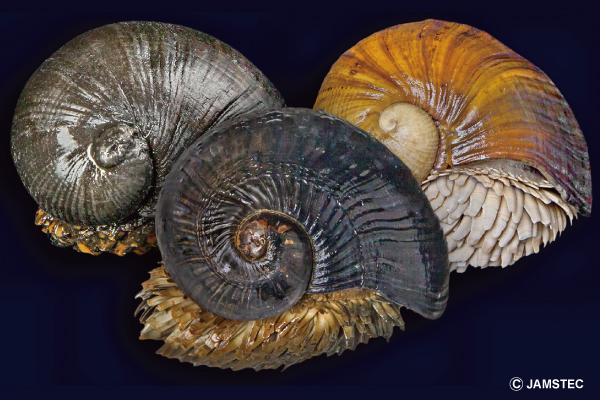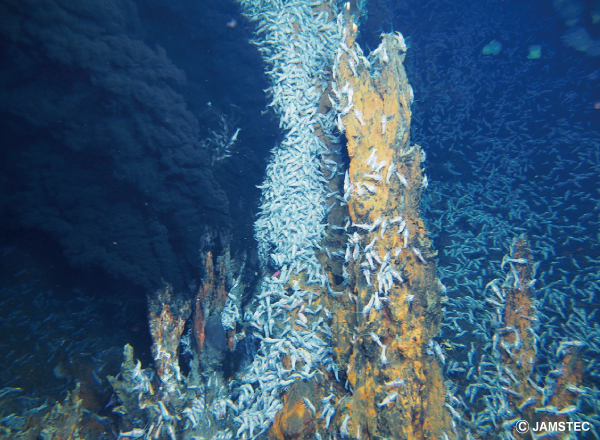- PROJECT MOTHER
- someone
- Information for Middle and High School Researchers
Scaly Foot - Exploring the Secrets of Iron Sulfide Armor -...
2020.06.17
Researcher, Ultra-Advanced Research Program, Ultra-Advanced Research and Development Division, JAMSTEC
CHEN Chong three // Norio Miyamoto Interview with Mr.
The bottom of the deep ocean, where hydrothermal activity spews out hydrothermal fluids and hydrogen sulfide at temperatures exceeding 300°C, is a harsh environment for ordinary animals to live in. The scaly-foot, discovered in 2001 in a hydrothermal active zone of the Indian Ocean, is a 3 to 5 cm (1 to 2 inch) long reef mollusk with a distinctive metal armor clad appearance.
Metal armor for protection?
Scaly-footed mollusks are the only mollusks whose feet are covered with scales. Among the 100,000 or so species of coiled mollusks currently known, the scaly-foot is a special species that has evolved in a unique way. The scales and shell of the first Scalyfoot were covered with iron sulfide, giving it the appearance of shiny black armor. Because of the hardness and iron sulfide content of this armor, it was initially thought to be used for protection against crabs and other enemies. However, in 2009, a white scaly-foot was found that did not contain iron sulfide. It became clear that the amount of iron sulfide contained in the armor varied with the change in habitat. Is this armor really for protection? Detailed examination of the scales revealed that they functioned to expel the metabolites of symbiotic bacteria that used hydrogen sulfide as an energy source in the body of the scalyfoot. However, no one knew how they acquired their specialized scales during the evolutionary process. CHEN Chong and MIYAMOTO Norio succeeded in decoding the entire genome of the scaly-foot at the chromosomal level and found the factors necessary to elucidate the mechanism of scale formation.

Scalyfoot. Iron sulfide content and color vary depending on the habitat.
Unraveling the History of Hard Scales
First, CHEN and MIYAMOTO examined in detail the genome sequence of the scaly-foot and gene expression in different tissues and organs, and found 25 important genes involved in the formation of scales and shells. Furthermore, comparison with other mollusks, closely related gobiids, and brachiopods revealed that these genes were already present in the Cambrian Period, approximately 540 million years ago, and constitute the "toolkit genes" that were key to the evolution of various hard tissues. In addition, the same hard tissues, shells and scales, each used a completely different set of genes. In other words, these special scales were produced by a completely new combination and use of genes in a gene set that has existed since the Cambrian period. The pure question of how this creature got this shape is my starting point," says CHEN. By tracing the ancestral links through high-precision genome analysis, he was able to discover the evolutionary path of more than 500 million years of hard tissue.

▲ Deep-sea hydrothermal vents inhabited by black scalyfoot.
The difficulty of approaching the mystery of deep-sea life.
In order to study scaly-footed boobies, we first need to collect them, but they live in the deep sea, which is not an easy place to go. Using manned research submersible "Shinkai 6500" and other vessels, we dive to a depth of about 2,500 meters, navigating the seafloor with few landmarks to find their habitat. Even if they reach their habitat, it will be a challenge to catch them because of the murky steam and poor visibility.
Even if the scaly-foot could be captured, the method of rearing it has not yet been established, and it would only live for about a month in the laboratory, no matter how long it lived, making research with deep-sea organisms not easy. However, Miyamoto said that despite the many difficulties involved in research on deep-sea organisms, "each time we encounter a different creature, we have the pleasure of unraveling their mysteries little by little. The otherworldly world of the deep sea is hard for us to imagine. Encounters with the creatures that live there may offer us the chance to make incredible discoveries that will greatly overturn our common sense.
(Text by Shodai Takino)
